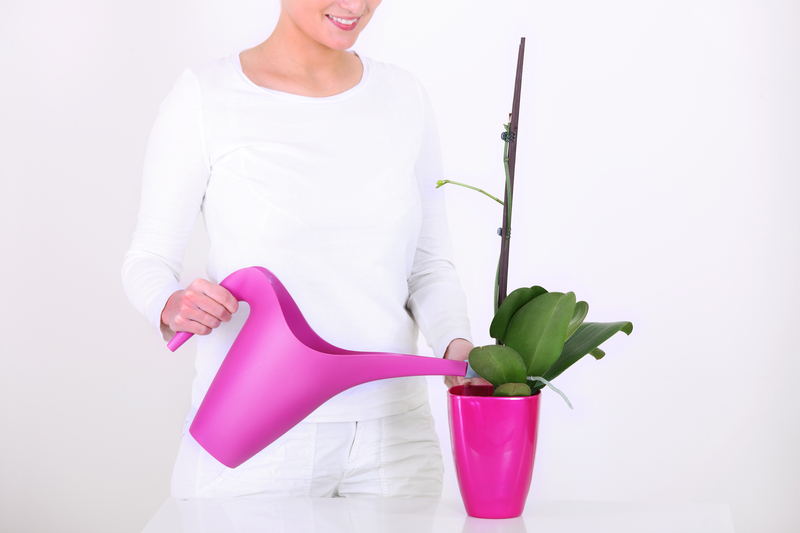Elevate your ecosystem with vertical gardening
Posted on 22/08/2025
Elevate Your Ecosystem With Vertical Gardening: A Comprehensive Guide
Are you searching for fresh ways to enhance your environment and make the most out of limited space? Elevate your ecosystem with vertical gardening and discover how this innovative approach can transform your home, workspace, or urban community. In this article, we will explore the many benefits and techniques of vertical gardening, offering comprehensive insights and practical tips for both beginners and seasoned green-thumbs.

What is Vertical Gardening?
Vertical gardening is the art and science of growing plants upward rather than outward, utilizing vertical spaces such as walls, trellises, towers, or hanging structures. Instead of spreading plants on flat beds, you grow them upwards with the help of supports or containers mounted vertically. This method maximizes available space, making it ideal for urban settings, small yards, balconies, and even interior environments.
Understanding the Principles of Vertical Gardening
At its core, vertical gardening relies on a few fundamental principles:
- Hydroponics or soil-based systems: Plants can thrive in traditional soil or soilless hydroponic setups.
- Support structures: Frameworks like trellises, green walls, towers, or shelves provide stability and arrangement for plants.
- Efficient irrigation and drainage: Special care is given to watering systems to prevent overwatering and nutrient runoff.
- Strategic plant selection: Choosing plants adapted to vertical environments and prevailing light conditions is crucial.
Why Elevate Your Ecosystem With Vertical Gardening?
Urbanization has reduced green spaces, making the concept of elevating your ecosystem vital for sustainability, personal health, and aesthetic appeal. Vertical gardening benefits extend far beyond visual enhancement. Here's how it can positively impact your space and wider environment:
1. Space Optimization:
- Great for apartments, offices, schools, and urban homes with minimal ground area
- Allows outdoor and indoor gardening in limited square footage
- Maximizes airspace, turning blank walls or fences into lush, productive gardens
2. Improved Air Quality & Microclimate Control
- Plants in vertical gardens filter pollutants and particulates from the air
- They increase oxygen content and contribute to humidity regulation
- Vertical greenery acts as natural insulation, lowering temperatures and reducing urban heat effects
3. Enhanced Biodiversity & Ecosystem Health
- Attracts pollinators such as bees and butterflies, supporting local biodiversity
- Offers habitat for beneficial insects and birds
- Creates microhabitats for various plant and animal species within limited space
4. Fresh Food Production & Nutrition
- Grow fresh herbs, vegetables, fruits, and even edible flowers at home
- Reduce your grocery bills and carbon footprint
- Enjoy improved food quality, picking produce at peak freshness and flavor
5. Mental and Physical Wellbeing
- Gardening is a proven stress-reliever, boosting mental health and mood
- Encourages exercise and outdoor activity, even in compact spaces
- Enhances aesthetic value, creating calming and beautiful environments
Different Styles and Structures for Vertical Gardens
When you decide to elevate your ecosystem with vertical gardening, you will find a variety of systems and designs to suit different settings and budgets. Here are the most popular types:
Living Green Walls
Often seen in offices, malls, or stylish homes, living walls feature densely planted panels or pockets anchored to vertical surfaces. These can be self-irrigating and often use a hydroponic medium for clean, efficient growth. Living walls are perfect for adding greenery indoors or outdoors, purifying the air and serving as striking focal points.
Trellis and Lattice Structures
Creepers, climbers, and vining vegetables such as beans, cucumbers, or squash thrive when grown on trellises or lattices. These structures are easy to install, extremely versatile, and add architectural interest to fences, patios, or balconies.
Hanging Gardens and Pocket Planters
For smaller spaces, consider hanging baskets, pocket planters, or vertical shelving units. These systems can be affixed to walls or suspended from ceilings, offering flexibility for creative arrangements. They are ideal for kitchen herbs, flowering plants, or trailing succulents.
Vertical Towers and Stackable Containers
Compact tower gardens or stackable pots allow you to cultivate tiers of leafy greens, strawberries, or flowers in cylindrical or pyramidal arrangements. These systems often come with integrated irrigation and are excellent for patios, rooftops, and community gardens.
Pallet and Upcycled Gardens
Resourceful gardeners use recycled materials such as old pallets, bottles, or crates to construct unique vertical gardens. Diversifying your ecosystem with upcycled structures not only reduces waste but adds character and sustainability to your green space.
How to Start Your Own Vertical Garden: Step-By-Step
Ready to elevate your ecosystem with a vertical garden? Follow these actionable steps to create a thriving vertical oasis:
1. Choose the Right Location
- Assess available vertical surfaces - consider sun exposure, wind, and accessibility.
- Balconies, fences, exterior and interior walls, or windowsills can all serve as vertical gardening sites.
- Indoor vertical gardens often require supplemental grow lights for optimal results.
2. Select Your System
- Determine if you prefer living wall panels, trellises, towers, shelves, or hanging containers.
- Establish a budget and consider existing materials you can repurpose.
- Ensure the chosen structure supports the weight of mature plants and moist soil or growing medium.
3. Pick Suitable Plants
- Sunny locations: Tomatoes, peppers, strawberries, petunias, succulents, and most herbs.
- Shady or partial shade: Ferns, lettuce, spinach, kale, English ivy, philodendrons, and peace lilies.
- Climbing plants like sweet peas, honeysuckle, or jasmine add vertical beauty with their natural growth habits.
4. Set Up Irrigation and Drainage
- Install drip irrigation for large vertical gardens or self-watering systems where possible.
- Ensure good drainage to prevent root rot and allow excess water to escape.
- Monitor moisture levels carefully - elevated gardens tend to dry out faster.
5. Use Quality Soil or Medium
- For soil-based systems, choose lightweight, nutrient-rich potting mixes.
- For hydroponic systems, utilize soilless media like coconut coir, perlite, or rockwool.
- Enrich your medium with organic matter and slow-release fertilizers as needed.
6. Plant, Maintain, and Enjoy!
- Arrange plants based on light and water needs - group similar species together.
- Prune and harvest regularly to encourage healthy growth and continuous yield.
- Check for pests and diseases often, especially in dense plant arrangements.
- Feed your garden with organic fertilizers or compost tea to maintain fertility.
Best Plants for Vertical Gardens
Choosing the right plants is essential for the success of your vertical gardening project. Here is a selection of versatile species that thrive in vertical environments:
Edible Plants
- Lettuce, arugula, spinach, Swiss chard
- Herbs: basil, mint, parsley, oregano, chives, thyme, cilantro
- Strawberries, dwarf tomatoes, chili peppers, pole beans, peas
Flowering & Ornamental Plants
- Petunias, nasturtiums, lobelia, pansies, violas
- Ferns, begonias, bromeliads, trailing ivy
- Orchids and air plants (Tillandsia) for exotic effect
Succulents and Indoor Plants
- Jade plant, echeveria, sedum, string of pearls
- Pothos, spider plant, philodendron, peace lily
Eco-Friendly Tips for Vertical Gardening Success
To further diversify and elevate your ecosystem sustainably, follow these green gardening practices:
- Collect rainwater: Use rain barrels to irrigate your vertical garden and reduce water use.
- Compost: Recycle kitchen scraps into compost to nourish your plants and minimize landfill waste.
- Use organic pest control: Attract ladybugs, lacewings, and birds for natural pest management.
- Select native and pollinator-friendly plants: Support local wildlife and ecosystem resilience.
- Repurpose materials: Upcycle old pallets, bottles, or containers instead of buying new ones.
Common Challenges and How to Overcome Them
Vertical gardening comes with a few unique challenges, but you can overcome them and experience lasting success:
- Watering issues: Elevated systems may need frequent watering. Install drip irrigation and monitor soil moisture regularly.
- Structural concerns: Ensure walls or supports can handle the combined weight of plants and water. Use lightweight soils and containers.
- Pest management: Dense planting can encourage pests. Incorporate companion plants and keep foliage trimmed for airflow.
- Sunlight variations: Place sun-loving plants at the top and shade-tolerant ones below or in darker spots.
- Nutrient depletion: Feed your vertical garden with organic fertilizer to sustain healthy growth in confined root zones.

The Future of Vertical Gardening
The movement to elevate your ecosystem with vertical gardening is gaining momentum worldwide. From eco-friendly skyscrapers to smart home installations, vertical gardens are changing the landscapes of cities, homes, and businesses. These living systems help combat climate change, reduce pollution, and enhance urban resilience. As technology and innovation progress, expect more intelligent, sustainable, and integrated vertical green solutions in everyday life.
Conclusion: Transform Your World with Vertical Gardens
If you're looking to elevate your ecosystem--whether it's a modest apartment balcony, a classroom wall, or a bustling office building--vertical gardening is a transformative solution. Not only does it make the most of limited space, but it also contributes to biodiversity, fresh food production, and human well-being. Embrace this sustainable gardening technique, experiment with different structures and plants, and watch your surroundings come to life--vertically!
Start today and join the green revolution. Elevate your ecosystem with vertical gardening, and cultivate a healthier, more beautiful world--one vertical surface at a time.



